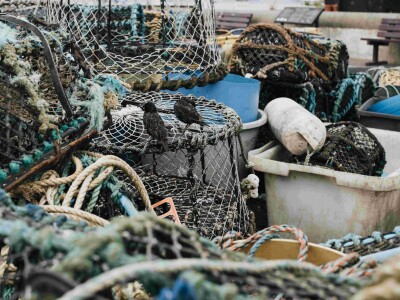Fire at the traps
From U.S. Coast Guard reports
At approximately 6:30 a.m., a skipper and sternman walked up to their 36-foot fiberglass-and-wood-hulled lobster boat, which was tied-up at its usual berth. The sun had been up for over an hour, and it was time to get to work. The men hopped aboard and, within a few minutes, the boat was underway and headed out of the harbor.
After clearing the harbor, the skipper set a course of 170 degrees, nearly due south, and bumped up the engine revs. The engine settled into a steady, familiar rhythm as the boat reached a cruising speed of 10 knots. This was a run that the skipper had made many times before. It was a pleasant but crisp mid-May morning, and the two men kicked back to enjoy the ride. Around 7:25 a.m. the skipper, as expected, had his traps in sight. He pulled back the throttle and allowed the boat to glide up to the first buoy. That’s when he and the sternman started to notice a smoky smell that was different from the diesel engine’s exhaust.
The skipper opened the door to the engine compartment and was met by thick black smoke and flames. The sternman rushed forward with an extinguisher at the ready. The skipper pulled the pin, moved into the compartment as far as he dared, and unloaded the contents of the extinguisher into the base of the fire. It was ineffective.
By 7:30, the smoke was getting heavier, and the fire had fully engulfed the engine room. Heat forced the skipper back out of the compartment, and he told the sternman it was time to abandon ship.
The skipper deployed their life raft; they donned their survival suits and abandoned the lobster boat. They skipper never got a chance to get a mayday call out over the radio, but had his cell phone and managed to contact a family member ashore, who relayed the position of the lobster boat and the situation to the local police.
It was nearly 7:45 when the police conveyed the information to the nearest Coast Guard command center. The Coast Guard put out an urgent marine information broadcast and diverted a 47-foot motor life boat to the lobster boat’s position.
In the meantime, a passing research vessel changed course to investigate, taking the skipper and sternman abroad until the Coast Guard arrived. The skipper and sternman suffered no injuries, but the vessel burned to the waterline. The next day the skipper went out to look for his boat, but it could not be found. The vessel was presumed sunk and was not recovered.
Lessons learned
Both men were seasoned fishermen, with over 35 years of experience between them. It was common procedure to board the boat, turn the key, throw off the lines and just go, without doing any type of a walk-through of the vessel. The engine on the boat regularly leaked oil; the men had accepted that as normal and dealt with the leak by cleaning the oil up with rags from time to time. There were no written standards or procedures onboard and, although voluntary at the time of the incident, the vessel had not had a dockside Coast Guard examination for eight years prior to the incident.
Nothing is worse than a fire at sea. Good engine room housekeeping and equipment maintenance are essential to prevent fires on your fishing vessel. Don’t let experience and familiarity with day-to-day operations lead to complacency. Take a few minutes before getting underway to do a walk-through of your boat to check safety items, inspect for any hazardous conditions and correct any problems you find. Don’t switch over to automatic pilot; stay on top of your game and fish safe!
This article is based on U.S. Coast Guard reporting and is intended to bring safety issues to the attention of our readers. It is not intended to judge or reach conclusions regarding the ability or capacity of any person, living or dead, or any boat or piece of equipment.







